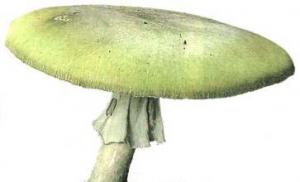Where do wild rabbits live? Where do wild rabbits live in nature
Many, seeing beautiful fluffy domestic rabbits, think that their wild relatives lead an equally carefree lifestyle, nibbling green grass in the meadows, but this is far from the case. For wild rabbits, every day is a struggle to survive in the harsh environment of the wild.
The lifestyle of wild rabbits is associated with the need to constantly search for food, regardless of the season, as well as the need to escape from predators that hunt rabbits.
The structure of the body of wild rabbits is determined precisely by the need to survive in the wild, because rabbits have unique adaptations for getting food from under the snow, a unique hearing that allows them to hear an approaching predator at a distance of 30 meters, regardless of whether danger arises from the air or creeps up earth.
Surprisingly, only European wild rabbits have been domesticated and are the wild ancestors of all modern domestic rabbit breeds.
The natural enemies of rabbits are absolutely all predatory mammals and birds. The biological age of wild rabbits is 15 years, but in reality, only 30% of rabbits live to the age of three in nature. The mortality of rabbits does not always depend on the activity of predators; diseases often become the cause of the death of an entire family of rabbits.
Rabbits in the wild are real babies compared to their domesticated relatives. Body length varies from 35 to 42 cm, weight ranges from 1.3 to 2 kg, in very rare cases, wild rabbits reach a weight of 2.5 kg. The body of the rabbit is squat, the paws are small, the ears reach only 7 cm, the eyes are black. The color of the skin is gray, with darker areas on the tips of the ears and tail. The wild rabbit molts twice a year, the spring molt takes place from March to May, and the autumn molt falls on September-November.
Wild rabbits prefer areas where there are bushy plants, but they can live in the steppes and even in dense forests and plantations, but rabbits avoid forest thickets. The lifestyle of wild rabbits is fundamentally different from wild hares. Rabbits do not need a vast territory to live. The family can live in a relatively small area, ranging from 3 to 20 hectares. In order to provide themselves with a comfortable existence, rabbits dig holes, which can sometimes reach 30 meters in length.
Unlike hares, wild rabbits do not lead an isolated lifestyle. Rabbits always live in families of 8-10 individuals and have a clear hierarchical structure. Wild rabbits are relatively unpretentious in terms of food, so they rarely go further than 100 meters from their hole. The main diet of rabbits is herbaceous plants, roots, tubers, grains, and bark. Such unpretentiousness allows the rabbit to quickly settle, capturing more and more new territories.
Initially, rabbits lived throughout southern Europe, but subsequently people settled them in almost all ecosystems, which led to a lot of troubles, for example, in Australia, where wild European rabbits had no natural enemies. Without natural enemies in Australia, rabbits began to actively breed, gradually displacing native rodent species.
The European wild rabbit is remarkably prolific. A female can bring up to six litters per year and, as a rule, from 2 to 12 rabbits in one litter. During the year, the female can produce from 20 to 60 rabbits, which quickly become independent after leaving the hole. Baby rabbits grow extremely fast, as they only feed on milk for the first 4 weeks.
After about 4-5 months, the rabbits reach sexual maturity, leave the family, forming their own families. Breeding of wild rabbits in Europe is currently carried out in nature reserves and nurseries. Some breeders want to buy wild rabbits to improve domesticated breeds.
Wild rabbits are extremely prolific, lead a secretive lifestyle and try to hide from predators. Despite the high mortality rate of rabbits of all ages, these amazing animals are perfectly adapted to life in the wild and support their population.
Rabbit is a mammal belonging to the hare family. Now, rabbits bred not only for food and its fur, but also as a pet. How do rabbits live in nature and what do they eat there? Today we will talk about it.
Rabbits in the wild
Wild European rabbit in length 31-45 cm, rabbit ears 6-7.5 cm, despite the fact that the skull is much smaller. The weight such a rabbit reaches 2.5 kg. Color its gray-brown, and on the back you can see a reddish color. Boca rodents of light color, stomach white, their tails are white, their ears are black and tail black. In rare cases, wild European rabbit can be found pure white, light gray or even mottled. places, where does this rabbit live: Sea of Azov, North Caucasus, Russia and in general, on all continents except Asia and Antarctica. chooses rabbit a place of residence with good soil so that you can easily dig a mink - quarries, ravines, coastal cliffs.
Types of wild rabbits
 How many species of rabbits are there in the wild? You will be surprised, but their number is not so great.
How many species of rabbits are there in the wild? You will be surprised, but their number is not so great.
1. Wild rabbit (European)
2. Water rabbit
3. Red rabbit
4. Idaho rabbit (pygmy)
5. Steppe rabbit
6. Nuttala rabbit
7. California rabbit
8. Tailless rabbit (teporingo or volcanic)
9. Rabbit Flanders
10. Rabbit Risen
11. Rabbit Gray giant
Most of the rest rabbit species, account for breeding by breeders, but we will talk about these types of rabbits (domestic) with you in other articles.
INTERESTING FACTS AND NUTRITION OF THE WILD RABBIT
What do wild rabbits eat?
 Wild rabbits eat stems and leaves of plants, in vegetable gardens or in fields, they get themselves cabbage, carrots, lettuce and various other crops. In the cold season food source is the bark of trees, branches of shrubs and trees. Interestingly, in the absence of any source of food, they eat their own excrement in order not to die of hunger. Of course, in can be fed at home the same (except excrement). Add in the diet you need hay, coniferous branches, dandelions, chicory, chamomile, yarrow, mouse peas, nettles, alfalfa, wheatgrass, chickweed. Can't feed parsley and dill, which contain essential oils. rabbits give both mineral stone and chalk. From fruits and vegetables, you can give cucumbers, zucchini, all kinds of cabbage, apples, carrots, watermelon and melon peels. With pleasure, rabbit gnaws white crackers. For grinding teeth, give willow branches, pears, apples, acacias, lindens, aspens. And with indigestion, a few branches of oak or alder.
Wild rabbits eat stems and leaves of plants, in vegetable gardens or in fields, they get themselves cabbage, carrots, lettuce and various other crops. In the cold season food source is the bark of trees, branches of shrubs and trees. Interestingly, in the absence of any source of food, they eat their own excrement in order not to die of hunger. Of course, in can be fed at home the same (except excrement). Add in the diet you need hay, coniferous branches, dandelions, chicory, chamomile, yarrow, mouse peas, nettles, alfalfa, wheatgrass, chickweed. Can't feed parsley and dill, which contain essential oils. rabbits give both mineral stone and chalk. From fruits and vegetables, you can give cucumbers, zucchini, all kinds of cabbage, apples, carrots, watermelon and melon peels. With pleasure, rabbit gnaws white crackers. For grinding teeth, give willow branches, pears, apples, acacias, lindens, aspens. And with indigestion, a few branches of oak or alder.
Rabbit can jump 3 meters
rabbits are animal pests for Australia. In 1859, the brought animals destroyed almost all stocks, from which it was decided to exterminate them immediately.
rabbits don't breed as fast as we think. Scientists have calculated that if rodents are not controlled, then they fill only 1 square meter in 90 years.
In Vietnam, in the universally accepted horoscope, a rabbit replaced with a cat. Why? Everything is simple - rabbits they don't have it.
VIDEO: WILD RABBIT
IN THIS VIDEO YOU WILL SEE HOW WILD RABBITS LOOK IN NATURE
The wild or European rabbit is the ancestor of all currently existing breeds. This species was domesticated by man in ancient Rome. Since then, rodents have been used to obtain dietary meat and fur.
Appearance
A wild rabbit is a small animal with a body length of up to 45 cm and a weight of up to 2.5 kg. A characteristic feature of the animal is that the length of its auricles is always less than the size of the head, up to 7 cm, unlike hares, which have longer ears. The feet of the limbs of the rabbit are covered with short hair. The paws have long and straight claws.
The coat color of wild rabbits is predominantly gray-brown; in some individuals, a reddish shade of guard hairs predominates. The hairline on the central part of the back is slightly darkened, the tail at the end is also dark, almost black or painted gray, and it is white below. The fur on the sides of the body is always slightly lighter than on the back, and in the abdomen it is white or light gray. On the back of the head, behind the auricles of the animal, there are buffy spots.
Attention! The wool of a wild rabbit does not change color during the seasonal molt, which occurs in autumn and spring.
Spreading
The wild rabbit originally lived in the Iberian Peninsula, as well as in parts of France and northwest Africa. It is believed that in this area, characterized by a warm climate, animals were able to survive after the Ice Age. From here, thanks to the Romans, European rabbits came to the Mediterranean. In the territory of modern England and Ireland, animals were brought by the inhabitants of Scandinavia in the 12th century AD. During the Middle Ages, rabbits had already spread throughout Europe.
In the 18-19 centuries, wild rabbits were specially transported to different islands - Hawaiian, Canary, Azores, and released there for acclimatization and breeding. Animal colonies were supposed to serve as food for sailors. Toward the middle of the 18th century, eared rodents were brought to the territory of Chile, from where the animals independently moved to Argentina. Somewhat later, in the middle of the 20th century, European rabbits were brought to Australia, the USA and New Zealand.

At the moment, wild rabbits live wherever there are no harsh winters. These animals do not exist except in Antarctica and Asia.
Reference. Wild rabbits choose habitats where in winter the number of days with stable snow cover does not exceed 37.
Lifestyle
The European rabbit is sedentary, unlike the hare. Animals inhabit territories with rugged terrain and rich vegetation, since the latter serves as food for them. Animals can be found on the coasts of estuaries, in ravines, gullies. In dense forests, animals are not found, as well as in mountainous areas.
Wild rabbits often coexist with humans, populating the outskirts of settlements, landfills and wastelands. Since rodents have a need to dig holes, the composition of the soil matters to them. Loose soil is preferable for these animals than clay or rocky soil. Having taken a fancy to the territory, the animals mark it with their secret - they rub their faces against objects, scatter excrement and spray urine. These animals prefer to live in small groups in which:
- the leading role is given to the male producer;
- a dominant female with cubs lives with him;
- the group includes 1-2 more females with or without offspring, living in separate burrows.
Young males living in the same colony with the dominant one readily protect females and offspring. Rabbits have their own methods of communication, they warn each other of danger, come to each other's aid.
Attention! Wild rabbits are polygamous creatures, but some individuals create a family with one female and stay with her forever.
Of interest are the burrows of wild rabbits. They are different:
- Family. Only adult animals live in them. Such dwellings are equipped with several entrances and exits.
- Brooding. This type of burrow is intended for rabbits. The hatched females independently dig them not far from the family burrow. Brood holes have only 1 entrance, which also serves as an exit. The rabbits come there to feed the cubs. Leaving the nest, the female masks the entrance so that wild animals do not find offspring.

Burrows of family type are simple and complex. The former are intended for single females, and the latter for the dominant male with his family. Simple family burrows have up to 3 entrances and exits, while complex ones have up to 8.
Food
European rabbits eat plant foods. Fearing the attack of wild animals, they go out in search of food mainly at night. Animals do not move more than 100 meters from their homes. Hearing a noise or noticing danger, the animals immediately go to their holes.
The animals are fed by:
- wild herbs;
- garden crops;
- shrub shoots;
- roots;
- cereals;
- tree bark (when vegetation is sparse).
Important! In winter, plant food is not available, so the rabbits look for dry grass under the snow cover and dig up the roots of plants. When animals are hungry, they eat their own feces.
reproduction
In warm regions, wild rabbits breed throughout the year. For example, in countries below the equator, animals do not breed only when the vegetation burns out. Animals living in the central part of Europe actively breed from March to October. Animals that have settled in the northern territories of the European continent stop breeding in July-August. On average, the female brings from 4 to 8 births per year, depending on the climatic conditions in which she lives.
The duration of pregnancy in a wild rabbit is 30 days, sometimes childbirth occurs a little earlier or later. There can be 4-10 cubs in one brood. The fertility of females depends on the following factors:
- health conditions;
- diet;
- age (after 3 years, the fertility rate decreases).

Newborn rabbits are completely defenseless - there is no hair on their body, their eyes are closed. The rabbit builds a nest before the birth, putting fluff from her belly into it. She feeds babies with milk until the age of one month, although already 2 weeks after birth they leave the nest and try adult food.
Reference. The eyes of rabbits open on the 10-11th day of life.
The wild rabbit is the only representative of the rabbit kingdom that has been domesticated. He is the progenitor of all existing breeds, including decorative ones. This animal can be found almost anywhere in the world, with the exception of Antarctica and Asia. Acquaintance with this representative of the fauna helps to better understand what qualities and features are inherent in domestic rabbits, what they need, how they behave in different conditions.
European or wild rabbit (from the Latin Oryctolagus cuniculus) [animal kingdom > chordate phylum > mammalian class > placental infraclass > hare-like order > hare family] - a mammal, a representative of the genus of rabbits, which is of South European origin. It is this type of rabbit that is the only one that has been massively domesticated and is the forerunner of the entire modern variety of rabbit breeds. But there is also a bad experience of domesticating a wild rabbit, for example, when they tried to domesticate it in the original ecosystem of Australia, this led to an ecological disaster. The wild rabbit has been domesticated since Roman times, and is still a commercial animal that is raised for meat and fur.
Outwardly, a wild rabbit is a small animal that looks like a hare, only smaller in size. The body length of representatives of this species of rabbits ranges from 31 to 45 cm. Body weight can reach 1.3-2.5 kg. The length of the ears is 6-7.2 cm. The hind legs are rather small compared to other types of hares.
The color of the body of a wild rabbit is brownish-gray, in some parts a little reddish. The tips of the ears and tail always have a darkish color, and the belly, on the contrary, is white or light gray. Molting in wild rabbits is quite fast but not very noticeable, spring molting lasts from mid-March to the end of May, and autumn - from September to November.
The habitat of wild rabbits is quite wide, the largest population is concentrated in the countries of Central, Southern Europe and North Africa. There have been attempts to acclimatize the wild rabbit in the Americas, as well as Australia, which cannot be said to have been successful, but even today representatives of this species of rabbit can be found in these parts of the world.
The habitat of wild rabbits also varies considerably, they can live in almost all types of terrain (although they avoid dense forests),  they are absolutely not afraid of approaching settlements and can live even in mountainous regions (but do not rise above 600 m above sea level).
they are absolutely not afraid of approaching settlements and can live even in mountainous regions (but do not rise above 600 m above sea level).
The daily activity of a wild rabbit depends on the degree of danger to which he is exposed - the safer he feels, the more active he is during the day. The habitat area, which will be enough for a wild rabbit, is limited to 0.5-20 hectares. Unlike other types of hares, they dig fairly large and deep holes (the largest of them can reach 45 m long, 2-3 m deep and have 4-8 exits). And one more difference between a wild rabbit and other species is that they do not lead a solitary lifestyle, but live in families that consist of 8-10 individuals. In the whole structure of the life of wild rabbits there is a complex hierarchical structure.
In search of food, wild rabbits do not leave their holes for more than 100 m, so their diet cannot be called too diverse. In summer, leaves and roots of herbaceous plants predominate in it, and in winter - the bark and branches of trees, the remains of plants that they dig out from under the snow.
Wild rabbits breed quite often - 2-6 times, each time the hare brings 2-12 rabbits. Pregnancy takes 28-33 days, i.e. a year the female brings 20-30 rabbits. At birth, baby rabbits weigh only 40-50 grams, are completely bare of fur and are blind. Their eyes open only on the 10th day of life, and on the 25th day they can already feed on their own, although the female does not stop feeding them with milk for the first four weeks. They reach sexual maturity at 5-6 months. The maximum life expectancy of wild rabbits is 12-15 years, although most of them do not live up to three years.
A rabbit is a mammal that belongs to the order Lagomorphs, the hare family. These animals are not only bred for meat and fur, but also kept at home as decorative pets.

Rabbits are often confused with rodents, and were once included in the general class of rodents. An important difference between rabbits and rodents is that rodents have 2 incisors on the upper jaw, and rabbits on the upper jaw have 4 incisors growing one after another. Rabbits have 28 teeth in total. 16 teeth are located on the upper jaw: 4 of them are incisors and 6 molars on each side. 12 teeth are on the lower jaw: 2 incisors and 5 molars on each side. Newborn rabbits have 16 milk teeth (6 incisors and 10 false molars). Animals do not have fangs, and between the molars and incisors there is a space of about 3 centimeters.
The incisors are used to cut food, and the molars are used to chew it. Rabbit incisors are rootless and grow throughout the animal's life, increasing by an average of 2.5 mm per week. In connection with this fact, animals need to constantly consume roughage and erase the growing part of their teeth.

How long do rabbits live?
In the wild, the life expectancy of rabbits usually does not exceed 3-4 years. In conditions of competent home maintenance, rabbits live from 4-5 to 13-15 years. The oldest domestic rabbit died at the age of 19.
The lifespan of rabbits can vary depending on:
- breed affiliation,
- genetic traits
- feeding,
- in males - on the frequency of mating,
- in females - on the frequency of births.
That is why, if they do not plan to get offspring from rabbits, individuals are sometimes sterilized, which increases the life expectancy of animals.
Rabbits of meat and downy breeds live on average 4 years, but with reduced intensity or complete absence of reproduction of offspring and high-quality content, this figure increases to 5-7 years.
Decorative rabbits live at home from 5 to 8 years, although among them there are specimens that live up to 10-12 years.
Dwarf rabbits have an average lifespan of 5-7 years, however, with good and careful care, some individuals live 12-13 years.

Without the necessary information and experience, it is easy to confuse a rabbit with a rabbit, although these animals have a number of characteristic distinguishing features:

Where do rabbits live in nature?
Most species of rabbits live in North America, the second place is occupied by the countries of South America. Also, the modern distribution area of rabbits includes Africa, Western and Central Europe, the countries of Scandinavia and the Mediterranean, the islands of the Pacific Ocean and the Atlantic. However, thanks to the domestication of the wild European rabbit (lat. Oryctolagus cuniculus), which originally lived only in southern Europe, today these eared animals have spread to almost all continents.

Rabbits are animals that lead an exclusively terrestrial existence, most often choosing places with rugged terrain and fairly dense vegetation for habitat. They prefer to settle along gullies and ravines with steep banks, feel comfortable in forests, meadows and clearings overgrown with shrubs or tall grass. But the mountainous areas located above 500-600 meters above sea level, and heavily swampy areas, most species try to avoid.
Often rabbits live in close proximity to humans, choosing wastelands or landfills, as well as the outskirts of settlements. An important factor in choosing a habitat is the peculiarity of the soil: rabbits often dig holes, and sometimes entire systems of underground passages, so they try to choose areas with light soils, since it is quite difficult to equip a hole in clay and rocky soils. Quite often animals occupy ready-made holes dug and abandoned by other animals.

Most species of rabbits lead a sedentary existence, occupying a certain territory from 0.5 to 20 hectares, which is marked with an odorous secret. An individual plot is occupied by a family group of 8-10 adults, headed by a dominant male and female.
What do rabbits eat?
The basis of the diet of rabbits is the green parts of plants, and the menu is formed by available feed. In addition to herbs, wild and cultivated cereals, cabbage, lettuce, root crops, and sometimes small insects are eaten. The winter diet includes bark and branches of trees, underground parts of plants that can be obtained from under the snow. In the absence of food, rabbits practice coprophagy - eating their own feces.
Types of rabbits, photos and names.
The modern classification within the hare family distinguishes several genera of rabbits, most of which are American varieties. Below are descriptions and photos of some species:
- , he is European rabbit ( Oryctolagus cuniculus)
the only species of domesticated rabbit that gave life to many modern breeds. This small animal grows in length up to 31-45 cm with a body weight of 1.3-2.5 kg. The ears of a rabbit are shorter than the skull and have a length of 6 to 7.2 cm. The back of a wild rabbit is brownish-gray, may be reddish. A faded strip of light fur runs along the sides of the animal, forming a wide spot on the thighs. The belly is white or light gray, the tips of the ears are trimmed with black, the tip of the tail is black or gray, the bottom of the tail is white, the top is black-brown. In 3-5% of cases, there are rabbits of black, light gray, white or variegated color. The main habitats of the rabbit are rugged shrub landscapes: ravines, quarries, coastal cliffs - places with light, sandy soil, convenient for digging winding holes. Wild rabbits eat the leaves and stems of plants, in the fields and in the gardens they get cabbage, lettuce, and cereals. With the onset of cold weather, the main source of nutrition is the bark and branches of trees and shrubs, in the absence of food - their own excrement. The wild rabbit is settled on all continents except Antarctica and Asia. In Russia, it can be found in the North Caucasus and the Sea of \u200b\u200bAzov.


- water rabbit(Sylvilagus aquaticus)
swims well, due to which it got its name. A large animal grows in length up to 45-55 cm and has a weight of 1.6 to 2.7 kg. The general color of the rabbit's fur varies from red-brown to almost black, only the throat, belly and underside of the tail are white, and the eyes are outlined with a dark ring. The basis of nutrition is various herbs and cereals, including reeds. The water rabbit lives in swamps and other humid areas of the southern United States: from Texas to South Carolina.

- red rabbit(Pronolagus randensis)
a species of African rabbit that lives exclusively in the highlands. The red rabbit has a fairly large body with a length of 42 to 50 cm and large ears. The weight of a rabbit is about 2.3 kg. A distinctive feature of the species is a light silky coat of red-brown with gray color and a large brick-colored tail with a black tip. These animals feed on insects and all kinds of vegetation: cereals, foliage, fruits. The largest population of animals lives in the rocky mountains of Africa: in Zimbabwe and Namibia.

- Idaho rabbit, he is pygmy rabbit(Brachylagus idahoensis)
the smallest rabbit in the world, it has very short hind legs, and therefore it does not have the ability to move by jumping like other hares. Representatives of the species grow in length from 22 to 28 cm with a body weight of 250 to 450 g. The rabbit fur on the back is yellow-brown, the belly and paws are lighter. The Idaho rabbit is a typical representative of the fauna of the northwestern states of the USA (Idaho, Montana, Wyoming), where it usually settles in thickets of three-toothed wormwood, which is its main food source.


- Rabbit Nuttala(Sylvilagus nuttallii)
very similar to the American hare, but differs in smaller size and a characteristic brown spot on the back of the head. The length of the body of a mammal is 33-40 cm, the length of the tail is 2.5-5 cm. Representatives of the species have very long hind legs with large feet covered with long thick hair. The main color of the fur is light brown. The rabbit feeds on herbs such as wheatgrass, bluegrass and quinoa, in winter bark and plant branches are added. The Nuttala rabbit lives in the mountainous regions of Canada and the United States (from Arizona to the Cascade Mountains).

- California rabbit(Sylvilagus bachmani)
a large animal that grows up to 50 cm in length. The weight of a rabbit is about 4 kg. A distinctive feature is the rabbit's ability to successfully climb low trees and shrubs. The animal feeds on various herbs, berries and leaves of overgrown vegetation (for example,), in which it prefers to live. The range of the species extends across Central America along the Pacific coast from Colombia in the south to the Sierra Nevada in the east.

- steppe rabbit(Sylvilagus audubonii)
externally resembles the European wild rabbit, but differs in much larger ears with a vertical set. The size of the rabbits is from 33 to 43 cm with a weight of about 1.5 kg, and the length of the ears reaches 10 cm. The color of the back is grayish-brown, the belly is almost white. Steppe rabbits eat various cereals, herbs, as well as those growing in their favorite habitat - the desert pastures of the southwest of America. Also, the steppe rabbit can be found in more humid areas - pine-juniper forests. The range of the species extends across the western territory of North America through Texas to Central Mexico.

- tailless rabbit, he is volcanic rabbit or teporingo(Romerolagus diazi)
one of the smallest rabbits, which lives only in the mountains of Central Mexico near the volcanoes of Popocatepetl and Istaxihuatl. Its length does not exceed 32 cm, and its weight barely reaches 600 g. The animal is distinguished by compact, rounded ears and such a small tail that it is impossible to see it. Tailless rabbits live in pine forests located high in the mountains, often up to 4.2 km above sea level. The main food of a rabbit is herbaceous vegetation. The biotopes of these animals cover forests, steppes, meadows, pastures, deserts, as well as wet, swampy lands.

rabbit breeding
Rabbits are considered one of the most prolific mammals and can breed throughout the year, during which one female rabbit brings from 3 to 5 litters. The puberty of rabbits occurs at the age of 5-6 months, so the rabbits, born at the beginning of the year, are already able to breed in the summer. Rabbits are polygamous animals, although some individuals are monogamous, and males live on the site of a particular rabbit.


The gestation period for rabbits is 28 to 40 days, and there may be 2 to 12 babies in a litter, although usually 4 to 7. The largest documented offspring is 24 rabbits.
American rabbits build nests on the ground, burrowing females build a nest underground, lining the bottom with fluff combed from their stomachs.

Newborn rabbits usually weigh 40-50 grams and begin to see on the 10th day, and on the 25th day they are completely ready for independent life, although they feed on their mother's milk for another week.
Starting from 3-4 weeks of life, little rabbits begin to eat food in addition to mother's milk.

Despite caring for offspring, many females are ready to mate a few hours after giving birth.
In 60% of pregnancies, the embryos are resorbed, but on average, one female rabbit increases the total population by 20-30 rabbits per year.


Decorative rabbits: maintenance and care
The wild rabbit was domesticated over a thousand years ago, and since then various breeds of ornamental rabbits have been kept as pets. All potential rabbit owners should be aware that these chewing and digging animals can cause significant property damage.

The rabbit will need a spacious cage that is 4 times the size of the animal. Domestic rabbits are very sensitive animals, so the cage is placed in a place where there are no drafts and direct sunlight.
In the rabbit's dwelling there should be a place for a pallet, a drinker, a feeder, and preferably for a decorative shelter house. Sawdust, straw or shavings are poured into the pallet, which are changed regularly.

What to feed rabbits at home?
The basis of the diet of a domestic rabbit is hay, which should always be plentiful, feed and water. Feed pellets are important for normal digestion, hay provides thick feces, and water must be boiled and always fresh.


Additional food for ornamental rabbits may consist of various herbs: chamomile, mouse peas, alfalfa, chickweed, yarrow, oak in small quantities.
Salt and vitamin stone, chalk are used as mineral additives. In summer, young leaves of trees are added to the diet, in winter - sprigs of conifers.

Rabbit breeds with photos and names
Today, in rabbit breeding, there are many breeds of rabbits, while animals are usually divided into several groups according to productivity, depending on body weight and hair length. This classification highlights:
- meat breeds,
- Fur (meat-skin) breeds,
- downy breeds,
- Decorative and dwarf breeds.
There is also a classification of breeds by country. Below are just a few of the countries:
- German breeds of rabbits (German motley giant, Riesen, German ram, German ober);
- Soviet breeds of rabbits (Soviet chinchilla, Soviet Marder, Russian ermine, Gray giant);
- French breeds of rabbits (Alaska, French Papillon, Champagne, French Sheep, Rex, Chinchilla, Burgundy, Silvery, Hotot, Harlequin);
- American rabbit breeds (California, New Zealand White, American Sable, Palomino, Silver Fox, American Fluffy Fold).

Rabbits of meat breeds, photo and description
Rabbits of meat breeds have a fairly developed musculature, are quickly fattened and are distinguished by a large slaughter weight. Young animals are ready for sale for meat already at the age of three to four months, and by six months the rabbit gives a good skin. Below is a description of some meat rabbit breeds with photos:
- burgundy rabbit
This is a breed bred in France. Animals have a slightly elongated body with a short neck and a fairly wide back, chest and croup. Burgundy rabbits grow very quickly and gain weight: at the age of four months, an individual reaches a weight of 4-4.5 kg. Such precocity of the breed is very much appreciated by rabbit breeders who raise rabbits for meat.

This is a French breed of rabbit. The animal is distinguished by a strong, but harmonious constitution with well-developed muscles. Silver rabbits have a body length of 54-57 cm, as well as large and wide chest and croup. The weight of an adult rabbit is from 4.5 to 6.7 kg. A distinctive feature of the breed is a silver-smoky shade of fur, which is evenly colored throughout the skin.

Breeders still argue about the origin of the breed and have not come to a consensus about the country in which the Flanders appeared, although they are more inclined towards Belgium. Rabbits of the Flanders breed are quite large in size: with a slightly elongated body length of 65-67 cm, the weight of the animal can reach 10-12 kg. The color of thick fur varies from gray to gray-black, grayish-red, sandy, silvery or white. The Flanders rabbit is very prolific and unpretentious in care, it grows quickly, therefore it is considered one of the best meat breeds.


- Rabbits Risen
This breed is from Germany. Today, Risen rabbits are considered the largest among their eared counterparts. With a massive body length of 70-75 cm, some specimens reach a weight of 12-14 kg. The color of the skin can be very different: dark gray, sand, blue, black, brown-gray.


- California rabbit
This is a meat breed of rabbits, bred in the USA. Animals have a special color: the body is white, and the tail, nose, limbs and ears are black, chocolate and blue-gray. The massive stocky body perfectly meets the criteria inherent in meat breeds. Rabbits of the Californian breed are growing rapidly: five-month-old animals weigh 3-3.7 kg, and at the age of six months they gain weight up to 6-7 kg.















